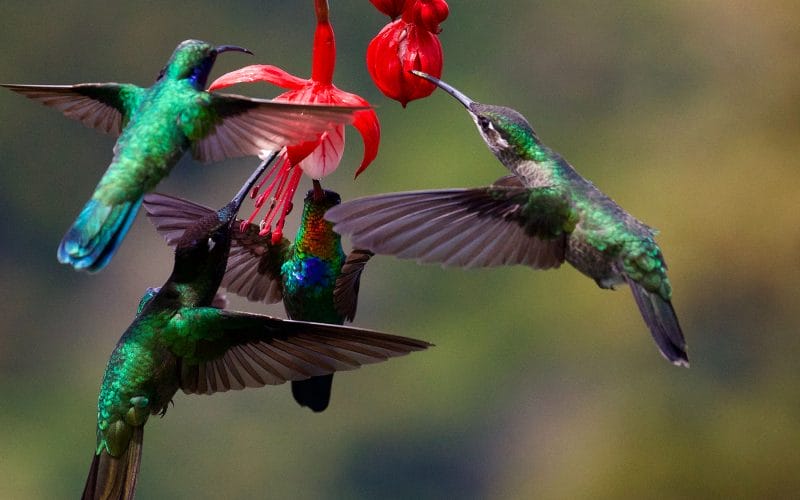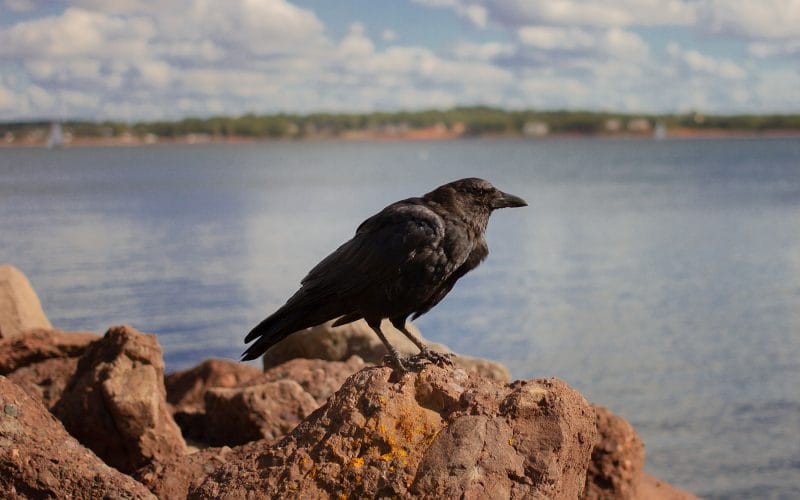
Adult eagles generally stay within their chosen territory as long as there is enough food and water around. Younger eagles usually fly further distances while hunting as they are less experienced. Eagles can fly for 2-4 hours without landing. This depends greatly on the type of eagle, age, and fatigue. But why do eagles fly alone?
Eagles fly alone because they are solitary, territorial birds of prey. They are not social birds unless they are mating or teaching fledglings to fly or hunt. Eagles fly high up in the sky, scanning for food. An eagle can spot a rabbit in an open field from nearly a mile away.
It will most likely be a breeding pair with a fledgling if you see two or three eagles together. Eagles mate for life, and both take part in hunting and nest building. Birdwatchers often love seeing these birds of prey flying across the expansive sky.
An Aerie of Eagles
A group of eagles is called an aerie. The only time eagles may flock together with other birds is if they are swooping to get in on a feast. As the saying goes, “Birds of a feather stick together.” Another collective noun for an aerie of eagles is a convocation.
Eagles are unique birds as they generally prefer to fly solo. Adult eagles often fly at extremely high altitudes reaching up to 10 000 feet. They are one of the only birds to fly above the clouds in order to avoid the rain.
The word ‘aerie’ can also refer to the eagles’ nest. Both the male and female eagle share the task of building a cozy nest. Branches, leaves, sticks, and bits of flora found in the area are used for nest building. Eagles choose to build these massive structures on high cliff faces or in tall trees.
Do Eagles Migrate?
Author Note: If there is sufficient food and an open water source, then eagles will stay in the same area all year round. Eagles are territorial and don’t generally fly too far away from their nest if they can avoid it. If there is not enough food or if it is too cold, eagles will migrate.
Many eagles fly South for the winter months, seeking food and better weather. Returning North in the summer, eagles often fly back to the same nest to lay eggs.
Age can also determine whether or not a bird migrates.
Eagle Fledglings

Young eagles begin to take their first flights at 9-10 weeks old. By now, they are almost fully grown and have developed most of their wing and tail feathers. At this age, they are still reliant on their parents to hunt for food and bring it back to them.
The male eagle does most of the hunting while the female eagle mostly looks after and feeds the chicks. They are known to switch places, and the male is quite happy to sit on the nest while the female is away.
While learning and practicing how to fly, eaglets will remain near the nesting area, and their parents will bring their food to them, wherever they are perched.
The mother eagle will encourage the fledglings to leave the nest with ‘tough love.’ They have been known to nudge their young out of the nests, forcing them to learn to fly. She will also make the nest less comfortable by removing soft materials and exposing harder sticks.
Leaving the Nest
As the chicks venture further away from the nests, they develop better flight skills. They start to scavenge on animals that are already dead as their hunting skills are not very good. They also start to challenge their parents for fish as their flying skills get better.
At 17-23 weeks old, they start to rely less on their parents. The young eagles leave their familiar territory and begin to become independent foragers. Diet depends on the species of eagle. They feed on small animals they can catch as well as animals that have died.
A young eagle may spend up to 4 years alone, discovering its favorite winter and summer spots. They will also determine good hunting grounds and roosting spots. The faster their flying and hunting skills develop, the better chance they will have to survive alone in the wild.
Young Adult Eagles
Author Note: An eagle starts to mature at the age of four. By now, the eagle is a talented hunter and can survive and navigate the wild. The young adults have an excellent, attuned vision and have mastered their flying skills.
Around this time, the bird will start searching for a life partner and establishing its own territory. Female eagles will test the commitment of a male by dropping a stick from a certain height. The male will catch the stick and bring it back to the female. In turn, she will drop it from higher up and repeat the process until she trusts her new mate.
Once the young adults have formed a bond, they will begin the process of building a nest together. Eagles usually settle within 250 miles of where they grew up.
They will not usually produce any eggs as a pair the first year. The following year they will return to the same nest to become new parents, mated for life. Females can lay up to 3 eggs in one clutch. Eggs are incubated for about 35 days before hatching.
Eagle Wings and Feathers
Eagles have powerful wings and use them with great skill. Their wings are strong, aerodynamic, and lightweight, enabling them to be fantastic flyers and acrobats. Eagles have been known to spiral down towards the ground at rapid speeds and time their exit perfectly.
Eagles can slow themselves down or speed themselves up by altering their wing position. They can fly up to very high altitudes without using too much energy. Once they spot their prey, they can swoop in at up to 200 miles an hour to catch it. Now that’s fast food!
A Bald eagle can have more than 7000 feathers. Feathers are light and innovatively overlap each other. Females can have a wingspan of up to eight feet long, with each wing weighing less than 2 pounds.
Feathers play a vital role in keeping birds warm and waterproof. They enable flight and add to the birds’ beauty. When looking for a mate, birds are known to show off or ruffle their feathers.
An eagle’s feathers can be divided into three different categories:
- Flight feathers are long and wide. They cover the largest part of the eagle – the wings and tail. They are light and do not add excess weight to the bird.
- Contour feathers are usually the feathers with the most color. They cover the bird’s body.
- Down feathers are soft and fluffy. They are found underneath the contour feathers and help to keep the bird warm.
Life Lessons from the Eagle

Eagles are majestic, powerful birds known for their ability to soar high in the sky. As we grow up, we are encouraged to ‘spread our wings and fly.’ Phrases such as ‘Aim high’ and ‘Soar with the eagles’ are common, encouraging ways to show support.
Here are some lessons we can learn from eagles:
Eagle Leadership Qualities
1- Eagles fly alone or with their own kind.
Lesson: Associate yourself with people on the same level as you so you will be able to grow together. Be careful of wasting time on negative people or surroundings. Instead, focus on people with common goals and dreams so you can help and encourage each other to grow.
2- Eagles have fantastic concentration and vision. They focus intensely on their prey and swoop in with willpower and determination.
Lesson: Focus on your goals. Try to achieve one thing at a time with the best use of your time, energy, and effort. Start something with the intent of finishing it within a dedicated timeframe.
3- Eagles test commitment levels before engaging in anything.
Lesson: It is important to trust the people we walk our lives with. Whether it be in our personal or professional lives, it’s crucial to determine others’ commitment level.
4- Eagles enjoy a good storm. They use the winds to carry them up above the clouds.
Lesson: During challenging times, lookout for new opportunities. Hardships enable us to grow, learn new skills, and become stronger.
5- Eagles are masters of managing change. They get out and face their world, adapting as they go. They are strong-willed and persistent. Mothers encourage their young to leave the comfort zone, spread their wings, and fly.
Lesson: It’s no good clinging to the old if it no longer serves us. People who genuinely care about us may seem harsh at times, but they really do have our best interest at heart.
Conclusion
Author Note: Eagles are powerful, solitary birds that fly alone to hunt their prey. The only time you will find them mixing with other birds is when they have a common food goal. An aerie of eagles is a rare and magnificent sight to see.
Eagles are known to return to their same nest each year if the conditions are favorable. They are territorial and usually build their nests within 250 miles of where they hatched. They are committed to their partner for life and raise strong, independent young.
If life is good, weather is favorable, and food is abundant, eagles will stay in the same area all year round. If times get tough, they will seek greener pastures and greater opportunities elsewhere.
Eagles hold powerful symbolism to many cultures and faiths. They are great forces to reckon with and have important life lessons to teach us. We hope you enjoyed this article on why do eagles fly alone.
Soar high friends!
FAQ
Eagles rely on thermals to gain height while using the minimum amount of energy. Thermals don’t occur over water so eagles rarely fly far away from the shoreline.
This is a really difficult question for researchers to find out. It is thought that some birds, including eagles, that fly a long distance can fly with one eye closed and in a state of semi-sleep.
No, they are experts at flying and they are well tuned physically to be good at it. They use thermals to minimize the amount of energy required and then glide so they don’t have to use energy to flap their wings.










